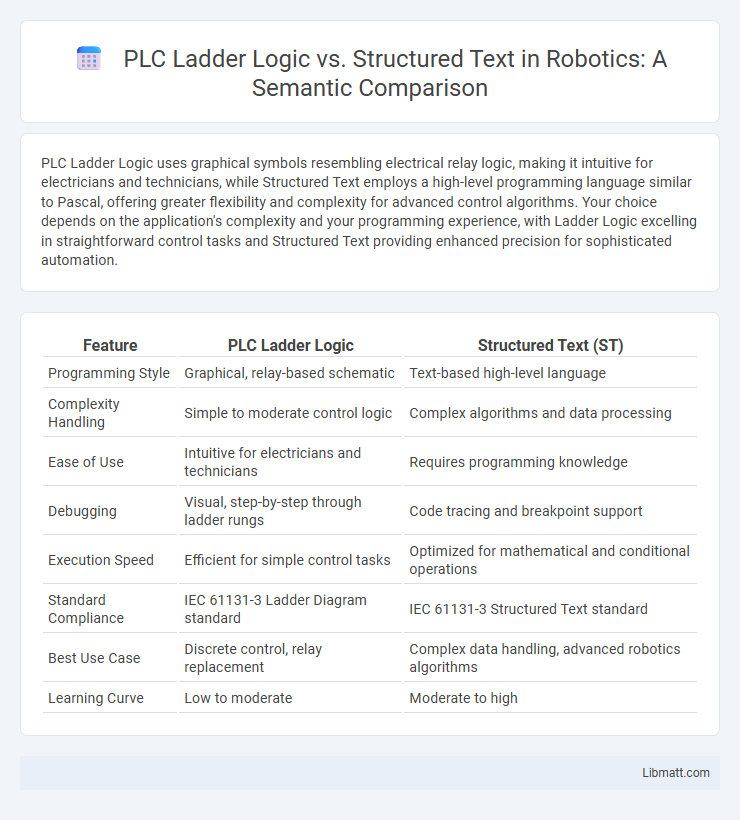PLC Ladder Logic uses graphical symbols resembling electrical relay logic, making it intuitive for electricians and technicians, while Structured Text employs a high-level programming language similar to Pascal, offering greater flexibility and complexity for advanced control algorithms. Your choice depends on the application's complexity and your programming experience, with Ladder Logic excelling in straightforward control tasks and Structured Text providing enhanced precision for sophisticated automation.
Table of Comparison
| Feature | PLC Ladder Logic | Structured Text (ST) |
|---|---|---|
| Programming Style | Graphical, relay-based schematic | Text-based high-level language |
| Complexity Handling | Simple to moderate control logic | Complex algorithms and data processing |
| Ease of Use | Intuitive for electricians and technicians | Requires programming knowledge |
| Debugging | Visual, step-by-step through ladder rungs | Code tracing and breakpoint support |
| Execution Speed | Efficient for simple control tasks | Optimized for mathematical and conditional operations |
| Standard Compliance | IEC 61131-3 Ladder Diagram standard | IEC 61131-3 Structured Text standard |
| Best Use Case | Discrete control, relay replacement | Complex data handling, advanced robotics algorithms |
| Learning Curve | Low to moderate | Moderate to high |
Introduction to PLC Programming Languages
PLC ladder logic uses graphical symbols resembling electrical relay logic, making it intuitive for technicians and engineers familiar with wiring diagrams, while structured text employs a high-level, text-based language similar to Pascal that supports complex algorithms and data handling. Ladder logic excels in simple control tasks and troubleshooting due to its visual nature, whereas structured text is preferred for advanced process control requiring loops, conditional statements, and modular code organization. Both languages are standardized under IEC 61131-3, offering flexibility to programmers depending on project complexity and industry requirements.
Overview of Ladder Logic
Ladder Logic is a graphical programming language widely used for programming PLCs, designed to mimic electrical relay logic diagrams for ease of understanding by engineers and technicians. It consists of rungs representing control circuits, making it intuitive for troubleshooting and real-time monitoring of industrial automation processes. Your choice to use Ladder Logic can enhance clarity in simple control applications where visual representation of logic is critical.
Overview of Structured Text
Structured Text is a high-level programming language used in PLCs for complex control algorithms and data manipulation, enabling easier handling of mathematical functions and loops compared to Ladder Logic. It offers a syntax similar to traditional programming languages, making it suitable for tasks requiring clear, concise, and modular code. Your efficiency in programming complex logic improves with Structured Text, as it supports functions, conditional statements, and arrays, which are challenging to implement in Ladder Logic.
Key Differences Between Ladder Logic and Structured Text
Ladder Logic uses graphical symbols resembling electrical relay diagrams, making it intuitive for electricians to understand and troubleshoot, while Structured Text relies on high-level, text-based code similar to programming languages like Pascal. You benefit from Ladder Logic's visual simplicity in straightforward control tasks, whereas Structured Text excels in complex mathematical computations and data handling due to its expressive syntax. Key differences include Ladder Logic's ease of visualization versus Structured Text's flexibility and scalability for advanced automation processes.
Ease of Learning and User Experience
PLC Ladder Logic offers intuitive visual representation resembling electrical schematics, making it easier for beginners and technicians with prior electrical knowledge to learn and troubleshoot. Structured Text provides a high-level, text-based programming language similar to traditional coding, appealing to users with software development backgrounds seeking more complex logic and flexible control structures. User experience varies as Ladder Logic excels in simplicity and immediate visual feedback, while Structured Text enables efficient handling of advanced algorithms and data processing.
Application Suitability and Industry Use Cases
PLC Ladder Logic excels in applications requiring straightforward, visual control systems, especially in manufacturing and automotive industries where relay logic replacement is common. Structured Text suits complex algorithms and data processing tasks found in chemical processing, HVAC, and advanced robotics industries due to its high-level programming capabilities. Both languages integrate well within IEC 61131-3 standards, allowing versatile deployment across diverse industrial automation scenarios.
Advantages of Ladder Logic
Ladder Logic offers intuitive visual representation, making it easier for technicians and engineers to understand and troubleshoot PLC programs quickly. Its resemblance to electrical relay diagrams enhances usability for those familiar with traditional control systems, reducing the learning curve. Your ability to implement simple control sequences efficiently is improved with Ladder Logic's straightforward, graphical approach.
Advantages of Structured Text
Structured Text (ST) offers superior flexibility and readability for complex algorithms and data manipulation compared to PLC Ladder Logic. It supports high-level programming constructs such as loops, conditional statements, and functions, enabling more efficient and maintainable control code development. ST's textual nature facilitates easier debugging, version control, and integration with software engineering tools used in advanced industrial automation projects.
Migration and Integration Considerations
Migration from PLC Ladder Logic to Structured Text requires careful evaluation of existing control systems to ensure compatibility and minimize downtime. Structured Text offers enhanced flexibility for complex algorithms but demands retraining of personnel and updated development environments to facilitate seamless integration. Proper version control and testing protocols are critical during migration to maintain system reliability and ensure smooth transition within industrial automation workflows.
Choosing the Right PLC Programming Language
PLC Ladder Logic offers a visual and intuitive approach, ideal for electricians and technicians familiar with relay logic, while Structured Text provides a powerful, text-based language suitable for complex algorithms and data handling in industrial automation. Your choice depends on the project's complexity, team expertise, and the need for readability versus advanced functionality. Structured Text excels in scalability and maintenance, whereas Ladder Logic supports easier troubleshooting and faster learning curves.
PLC Ladder Logic vs Structured Text Infographic

 libmatt.com
libmatt.com